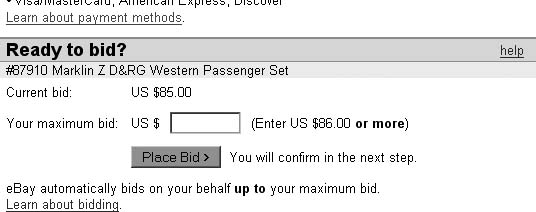Take Advantage of Bid Increments
A slight adjustment to your bidding strategy will help you save money and win more auctions.
Every auction has a minimum bid, a dollar amount shown just above the Place Bid button on the auction page, as shown in Figure 3-4. If the auction hasn’t received any bids, the minimum bid is the same as the starting bid. Otherwise, the minimum bid is equal to the current price plus a bid increment.

Figure 3-4. The Bidding Section shows the current bid increment and minimum bid
Bid increments, at least in theory, prevent bidders from outbidding one another by a single cent, and are calculated as follows:
Table 3-3.
Current price | Bid increment |
|---|---|
$0.01-$0.99 | $0.05 |
$1.00-$4.99 | $0.25 |
$5.00-$24.99 | $0.50 |
$25.00-$99.99 | $1.00 |
$100.00–$249.99 | $2.50 |
$250.00–$499.99 | $5.00 |
$500.00–$999.99 | $10.00 |
$1,000.00–$2,499.99 | $25.00 |
$2,500.00–$4,999.99 | $50.00 |
$5,000.00 and up | $100.00 |
For example, an auction currently at $68.45 will have a minimum bid of $69.45 (one dollar more), so you wouldn’t be able to bid $69.00 even though it’s higher than the current price.
Bid increments also come into play when calculating the current price. If there’s more than one bidder, the current price is equal to the second-highest bidder’s bid plus the bid increment. So if someone bids $114 and someone else bids $157, the current price will be $116.50 ($114 + $2.50), and the minimum bid for subsequent bidders will be $119 ($116.50 ...
Get eBay Hacks, 2nd Edition now with the O’Reilly learning platform.
O’Reilly members experience books, live events, courses curated by job role, and more from O’Reilly and nearly 200 top publishers.

